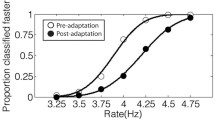Abstract
The “ventriloquist effect” refers to the fact that vision usually dominates hearing in spatial localization, and this has been shown to be consistent with optimal integration of visual and auditory signals (Alais and Burr in Curr Biol 14(3):257–262, 2004). For temporal localization, however, auditory stimuli often “capture” visual stimuli, in what has become known as “temporal ventriloquism”. We examined this quantitatively using a bisection task, confirming that sound does tend to dominate the perceived timing of audio-visual stimuli. The dominance was predicted qualitatively by considering the better temporal localization of audition, but the quantitative fit was less than perfect, with more weight being given to audition than predicted from thresholds. As predicted by optimal cue combination, the temporal localization of audio-visual stimuli was better than for either sense alone.








Similar content being viewed by others
References
Alais D, Burr D (2004) The ventriloquist effect results from near-optimal bimodal integration. Curr Biol 14(3):257–262
Andersen TS, Tiippana K, Sams M (2004) Factors influencing audiovisual fission and fusion illusions. Brain Res Cogn Brain Res 21(3):301–308
Arrighi R, Alais D, Burr D (2006) Perceptual synchrony of audiovisual streams for natural and artificial motion sequences. J Vis 6(3):260–268
Aschersleben G, Bertelson P (2003) Temporal ventriloquism: crossmodal interaction on the time dimension. 2. Evidence from sensorimotor synchronization. Int J Psychophysiol 50(1–2):157–163
Berger TD, Martelli M, Pelli DG (2003) Flicker flutter: is an illusory event as good as the real thing? J Vis 3(6):406–412
Clarke JJ, Yuille AL (1990) Data fusion for sensory information processing. Kluwer Academic, Boston
Dixon NF, Spitz L (1980) The detection of auditory visual desynchrony. Perception 9(6):719–721
Efron B, Tibshirani RJ (1993) An introduction to the bootstrap. In: Monographs on statistics and applied probability, vol 57. Chapman & Hall, New York
Ernst MO, Banks MS (2002) Humans integrate visual and haptic information in a statistically optimal fashion. Nature 415(6870):429–433
Fendrich R, Corballis PM (2001) The temporal cross-capture of audition and vision. Percept Psychophys 63(4):719–725
Gebhard JW, Mowbray GH (1959) On discriminating the rate of visual flicker and auditory flutter. Am J Psychol 72:521–529
Ghahramani Z, Wolpert DM, Jordan MI (1997) Computational models of sensorimotor integration. In: Morasso PG, Sanguineti V (eds) Self-organization, computational maps and motor control. Elsevier, Amsterdam, pp 117–147
Mamassian P (2008) Overconfidence in an objective anticipatory motor task. Psychol Sci 19(6):601–606
Mateeff S, Hohnsbein J, Noack T (1985) Dynamic visual capture: apparent auditory motion induced by a moving visual target. Perception 14(6):721–727
Morein-Zamir S, Soto-Faraco S, Kingstone A (2003) Auditory capture of vision: examining temporal ventriloquism. Cogn Brain Res 17(15):4–163
Parise C, Spence C (2008) Synesthetic congruency modulates the temporal ventriloquism effect. Neurosci Lett 442(3):257–261
Pick HL, Warren DH, Hay JC (1969) Sensory conflict in judgements of spatial direction. Percept Psychophys 6:203–205
Radeau M (1994) Auditory-visual spatial interaction and modularity. Curr Psychol Cogn 13(1):3–51
Rose D, Summers J (1995) Duration illusions in a train of visual stimuli. Perception 24(10):1177–1187
Sekuler AB, Sekuler R (1999) Collisions between moving visual targets: what controls alternative ways of seeing an ambiguous display? Perception 28(4):415–432
Shams L, Kamitani Y, Shimojo S (2000) Illusions. What you see is what you hear. Nature 408(6814):788
Shams L, Kamitani Y, Thompson S, Shimojo S (2001) Sound alters visual evoked potentials in humans. Neuroreport 12(17):3849–3852
Shipley T (1964) Auditory flutter-driving of visual flicker. Science 145:1328–1330
Stekelenburg JJ, Vroomen J (2009) Neural correlates of audiovisual motion capture. Exp Brain Res (in press)
Summerfield Q, McGrath M (1984) Detection and resolution of audio-visual incompatibility in the perception of vowels. Q J Exp Psychol A 36(1):51–74
Tse P, Intriligator J, Rivest J, Cavanagh P (2004) Attention and the subjective expansion of time. Percept Psychophys 66:1171–1189
Verghese P, Stone LS (1996) Perceived visual speed constrained by image segmentation. Nature 381(6578):161–163
Warren DH, Welch RB, McCarthy TJ (1981) The role of visual-auditory “compellingness” in the ventriloquism effect: implications for transitivity among the spatial senses. Percept Psychophys 30(6):557–564
Watson AB, Pelli DG (1983) QUEST: a Bayesian adaptive psychometric method. Percept Psychophys 33(2):113–120
Acknowledgments
This research was supported by the Italian Ministry of Universities and Research, EC projects “MEMORY” (FP6-NEST) and “STANIB” (FP7 ERC) and US NIH Research Grant EY-R01-08266 to MSB.
Author information
Authors and Affiliations
Corresponding author
Rights and permissions
About this article
Cite this article
Burr, D., Banks, M.S. & Morrone, M.C. Auditory dominance over vision in the perception of interval duration. Exp Brain Res 198, 49–57 (2009). https://doi.org/10.1007/s00221-009-1933-z
Received:
Accepted:
Published:
Issue Date:
DOI: https://doi.org/10.1007/s00221-009-1933-z




